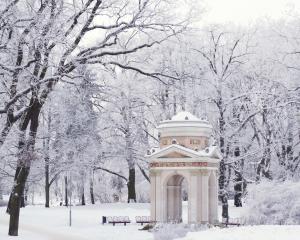
Don't worry", says our guide Charlotta, flashing her rifle. "I’m really quick if I need to be." My 12-year-old daughter glances around the Arctic wilderness anxiously. As much as she loved Philip Pullman’s armoured bears, one of the reasons she longed to visit, our proximity to the real thing is starting to dawn on her.
There are road signs all over town warning us about the risk of polar bears. They number around 3000 here, compared to 2500 or so human inhabitants — which is why the Svalbard authorities insist you walk beyond the main settlement only with an armed guide.
As a result, attacks are extremely rare — around five since the 1970s. The aim is for humans and bears to interact as little as possible: they’re protected by law and it’s a crime to hunt, feed or disturb them.
Charlotta isn’t taking any risks this morning. She loads four bullets into the gun’s barrel, clicks it shut and slings it across her shoulder. "Right, let’s go", she says and we follow her across the frozen tundra as she tells us about the life of the trappers more than 100 years ago, hunting foxes and polar bears, often alone and several days from civilisation.

We land during the last remaining hours of sunlight and our first sight of Svalbard is a bleak range of black spiky mountains swathed in cloud, a peach sun hanging below the horizon.
The Norwegian archipelago is about midway between Norway and the North Pole, and it’s one of the world’s northernmost inhabited areas. There are three main islands, and Spitsbergen is the largest. Longyearbyen, where we’re staying, is its main settlement, populated largely by tour guides, tourists, academics and researchers.

We stay closer to home, eating at Barentz gastropub (you’ve guessed it, "The northernmost pub in the world") attached to our hotel, the Radisson Blu Polar. The menu is varied and tasty; between us we enjoy a caramel milkshake, a glass of riesling and home-made pizza. The rooms are stylish, cosy and warm, while the Scandi buffet breakfast is a highlight; scrambled eggs and smoked salmon in the morning with views across the mountains is hard to beat.
Tempting as it is to lounge in the hotel — there’s a sauna and outdoor Jacuzzi — Svalbard is all about its outdoor activities. First stop is a glacier cruise aboard a hybrid electric catamaran, a greener way to explore the fiords with propellers that minimise noise and vibration.
"Welcome to nature’s cathedral", says Sam, our guide, as we set off. Sam, a marine biologist, is passionate about his subject. "This is where we watch climate change in real time." For Svalbard, real time is accelerating at an alarming rate — perhaps more swiftly than anywhere else in the world. Research suggests this whole area is warming six times faster than the global average. Some predict that in the next 70 years, its glaciers will lose ice at twice the current rate. He shows us a series of Nasa images that illustrate the dramatic rate of ice and glacier decline. The only way forward, he believes, is collective participation through science. "Get involved,’’ he enthuses to us. "Citizen projects in your local area is a good way to start. We need more eyes, counting birds, researching, collaborating."

Svalbard is full of strange stories and facts like these. For instance, no-one gives birth on Svalbard because there’s only one hospital and no maternity services, so pregnant women are flown to the mainland shortly before their due date. No-one can be buried here either — permafrost means bodies can’t decompose, leading to fears that viruses and infections can be preserved, too. And cats are banned because they might harm the wildlife, in particular the bird population.

We spend our final evening watching a blues band in a local bar. It’s packed and there’s a party atmosphere, dancing, singing and high spirits. It’s part of their annual Dark Season Blues festival, which marks the loss of daylight for the rest of the season. Svalbardians aren’t daunted by the extremes of living here and the challenges of the polar winter ahead. Instead they take pleasure and celebrate it — and you can see why.
Need to know
— A five-night break in Svalbard costs from $1257 per person, including B&B accommodation at the Radisson Blu.
— The Wildlife and Glacier cruise is $436 per adult, $235 per child, and husky on wheels is $252 per adult, $125 per child.
— Wilderness evening is $226 per adult, $120 per child.
— To book, visit: discover-the-world.com.
— For more information, go to visitnorway.com
— The Observer












